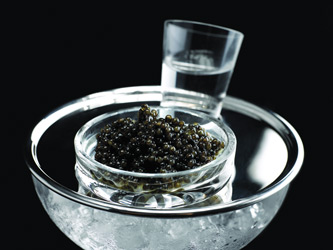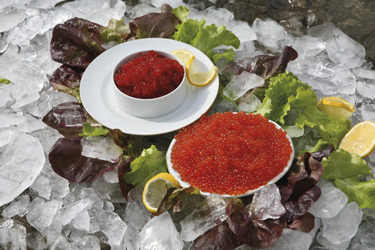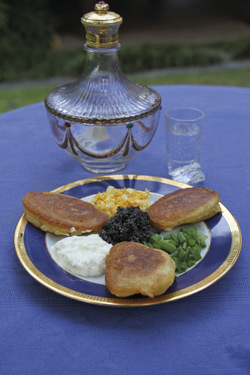 |
THE BLACK QUEEN OF RUSSIAN FEASTS
Caviar has survived till present day surrounded by myths and is deeply imprinted in foreign mentalities as something genuinely Russian by origin. We Russians by no means deny it, as it adds a sweeter note to the otherwise unpleasant cocktail of stereotypes about our country, whose main ingredients are: mafia, siloviki, vodka and "it is very cold there".
I felt proud and touched when I discovered that practically all research on the farming of sturgeon and the harvesting of caviar in such a way that the fish remain alive has been carried out by Russian and Soviet scientists. And they have generously shared their findings with the world, to boot. For instance, a French ichthyologist, Maurice Fontaine, convinced the Soviet government in the 1970s to give France an agricultural starter kit of live Siberian sturgeon, which would allow it to revive the caviar industry in the Gironde region, where the common European sturgeon had been in abundance for centuries before it was overfished. The result is the Caviar d'Aquitaine farm in Bordeaux, one of the most successful sturgeon farms in the world, whereas in Russia things are not that peachy.
The former USSR aimed to protect wild sturgeon on the brink of extinction, which resulted in the breeding of a completely new kind of species and the invention of a method of removing eggs without killing the fish, as had been done worldwide for centuries. So, when it comes to sturgeon and caviar, without which the history of Russia would have been slightly different, we have good reasons to be proud.
Living Fossils
It may be hard to believe but sturgeon are nothing less than prehistoric creatures whose appearance has changed very little since the time of the dinosaurs.
It becomes obvious when a sturgeon caught today is compared to the petrified impression left by its Jurassic predecessor. This fish has no scales as we know it; instead, it sports bony cover with sharp crests called scutes running along its sides. Such armour of hard plates capable of inflicting a painful poke to its attacker somewhat compensates for the passivity and clumsiness of the surgeon when in danger.
Sturgeon are easily recognisable by their sloping snouts and fleshy lips, which function similarly to the vacuum cleaner when they suck in mollusks, larvae and worms from the seabed. Beluga – a giant in the sturgeon family, weighing up to a tonne, spanning four metres long and very rare – may sometimes gulp down schools of herring, ducks and even baby seals.
Punctuality is the Politeness
of Not Only Kings
In the northern hemisphere, there is a great deal of sturgeon habitats, with about 27 kinds of the species known today. And yet, nothing beats the Caspian Sea, which is more like a salty lake rather than a sea. The abundance of sturgeon there may be explained by the species' preference for water of medium salinity, like in river deltas, where freshwater mixes with seawater.

While sturgeon live in the sea, they head upriver to lay their eggs. Different kinds of sturgeon choose different times. Some prefer to spawn in wintertime, others in summer, while a few come to rivers right before they freeze and go into hibernation under the ice, their snouts down in the silt, their tails upwards, until the thaw. During the conquest of Siberia a couple of centuries ago, Russian Cossacks would catch those dreamy fishes with their bare hands.
No less intriguing than their appearance is the spawning instinct of sturgeon, which brings them unmistakably to the same area, even to the same spot, where they had hatched many years earlier. According to fishery biologists, a stellate (sevruga) born in the Volga River would never travel up the Kura River when ready to spawn, although both rivers flow into the Caspian Sea and both are homes to populations of stellates.
Sturgeon Stories
Sturgeon used to be found in Europe, North America and Asia.  An ancient writer claimed that a single bowl of sturgeon meat in Athens cost the same price as 100 sheep and a bull. Pliny reported that a fanfare of trumpets announced the arrival of the platter bearing the sturgeon at the famous banquet celebrating Rome's defeat of Carthage, while Cicero noted that "this is a fish for only a few choice palates".
There are documented accounts of sturgeon caught in the Seine between the 17th and 19th centuries. The water of the Elbe also used to carry the fish, which, unfortunately, sooon disappeared having fallen victim to the sewage and industrial waste that was drained into the river.
In Native American mythology, poetically transformed by Henry Wadsworth Longfellow, there is an episode in which an Indian named Hiawatha throws in his fishing rod into the water thrice in an effort to catch the Great Sturgeon but instead, gets swallowed by the King of Fishes together with his canoe. Hiawatha remains cool and kills the fish by squeezing its heart from within. According to some accounts, the population size of the sturgeon in North America used to exceed that of the Caspian in the past. An American fisherman would sell a sturgeon for a song – mainly to farmers for fertiliser, as the first settlers considered its meat to be the food of savages, since the Indians valued its meat. Later, American colonisers would feed sturgeon to their black slaves as filling and inexpensive nosh.
From Rags to Riches
But in Russia the situation was just the opposite: live sturgeon were transported in wooden barrels filled with water across the steppe for thousands of miles to be presented to the kitchens of the tsar and nobility, while caviar was considered good enough for the poor only. In the 17th century, caviar was sold at all markets around St. Petersburg and cost no more than butter; two centuries later, it was still served at every inn and tavern across Russia, and its price was comparative to that of lard.
Ancient Slavs (the ancestors of today's Russians) had treated Mother Earth and its gifts with admiration and veneration, so any animal slaughtered or any tree fallen was utilised in full, leaving no part to go to waste. For instance, in the sturgeon, they valued not only its meat and caviar, but the fish's air bladder was also used to make glue, while its chorda (spinal cord) was processed to become delicious stuffing for pies. As for the caviar, in Russia, it was not only salted in order to preserve it, but it could also be cooked in porridge and even dried.
After Russia converted to Christianity, caviar became more prevalent in the everyday diet – this time, due to religious restrictions prescribing believers to avoid meat about 200 days a year.
 Caviar, like fish, was permitted on days and during fasts when meat was forbidden by the church.
Europe was introduced to the salty fish eggs relatively late – in the 14th century, when Venetian merchants came back from their journeys to the Black Sea carrying barrels of the foreign delicacy. Initially, it did not catch on. Francois Rabelais mentioned it in his book on several occasions, each time as something weird and useless. Shakespeare used the word "caviar" as a metaphor for obscurity: when Hamlet complains that his play was "caviar to the general", he means that it was beyond the comprehension of the general public. When the ambassadors of the Russian Tsar Peter I sent caviar to Louis XV as a present, the French King spat it out on the splendid carpet of his Versailles palace.
Thus, caviar's luxury status is a rather recent phenomenon. One driving force behind it was the Industrial Revolution, which gave the world life-changing inventions such as the steam engine. Thanks to it, the transportation of people and goods became less tedious and time-consuming, a far cry from travel by caravan that lasted for months at a time. The other factor that contributed to caviar's growing popularity worldwide was the emergence of a new class of consumer searching for exotic experiences and wealthy enough to pay for them. Due to all this, in a mere decade, sturgeon roe transformed from a food despised by the powers that be into a delicacy that has come to symbolise their power and affluence.
The Black, the Red, the Gold
In the Russian language, unlike in English, there is no specific word for caviar: it is simply called black roe
(chyornaya ikra) as opposed to red roe (krasnaya ikra). This colour-based division indicates the fish species: sturgeon, beluga and stellate eggs are black in colour, while the salmon species have red roe. The word "caviar" first came into the English language in the 16th century, probably by way of French and Italian, which borrowed it from the Turkish havyar, which, in turn, is originally the Persian word for "egg".
Beluga caviar is the biggest in size among all sturgeon, with grains of up to four millimetres in diameter. A female beluga can spawn as much as 200 kg of roe. Sturgeon eggs (osietra caviar, as it is more commonly known to consumers) are smaller - two to three millimeters - as the fish is smaller, too. Osietra caviar is valued for its subtle nutty taste. The stellate (sevruga) fish can be as long as two metres and weigh up to 80 kg; its roe is the smallest among the other sturgeon species.
On extremely rare occasions sturgeon eggs may have a slightly yellowish tint, and such caviar is called "golden". In the past, every fish with golden roe was delivered to the Russian tsar personally. Today, science has proved that yellow fish eggs, given the chance, would produce albino sturgeon.
Caviar varies not only by colour, but it may have additional names indicating its preservation method. There is caviar proper – meticulously harvested with each grain intact and easily separated from one another by hand. The caviar master separates the eggs from the egg sacks gingerly and carefully, so as not to burst the tender black granules, which are then rinsed with cold, salty water and mixed with high-quality coarse salt in the amount of four per cent of the roe's weight. This type of preservation is well known by the Russian name of malosol, which literally means "little salt". Such caviar is considered the best and freshest, but the downside is its short shelf life.
The second preservation method is the pressing of the roe, sometimes from different kinds of sturgeon, until it achieves the consistence of semi-hard cheese. Bricks of pressed caviar can be cut with a knife. When the Cossacks entered Paris in 1814, they carried barrels of pressed caviar with them, as it was easier to transport and less perishable than grainy caviar.
The third type of caviar is low-quality roe, which is preserved directly in the egg sack. It's a home-made preservation, never to be found in stores or restaurants.
Burtsev's Bester
Both Russian and international media have brought up, every now and then, the issue of illegal caviar and Russian poachers making fortunes by smuggling it into the US and Europe. But while they are fast to lash out at our country's ineptitude to put an end to it, few know that it was the former Soviet Union that, as early as 1962, banned the fishing of the sturgeon in the Caspian Sea to prevent the endangered species from being overfished and becoming extinct. Until the Soviet Union's collapse in 1991, there were only two states with access to the Caspian; today, there are five independent states surrounding the sea. Each pays little respect to the ban, which has a valid and objective point: when the seabed is trawled by nets, they capture all fish along the way, be it a female sturgeon full of ripe roe, males and even young fish not mature enough to produce eggs, which as such die meaningless deaths.
Russian ichthyologist Igor Burtsev, together with his colleagues from the Russian Federal Research Institute for Fisheries and Oceanography, created a cross between the giant beluga and the tiny stellate called "bester". It is almost as big in size as the beluga, but, like stellate, it matures much quicker (for the beluga, it takes 20 to 25 years) and produces large pearly, mild-tasting eggs. Since the bester can turn out a crop of eggs every two years, it is the perfect species for fish farms to raise for caviar.
Worried about the decline in the population of the wild sturgeon, Burtsev saw to it that the species was properly bred and treated in captivity. He perfected a method that allowed keeping a female sturgeon alive after harvesting its eggs by siphoning roe from live fish. He called it "milking", although the operation is the fish equivalent of a caesarean section: a sturgeon female is caught, given an anaesthetic shot and has its roe carefully removed through a slit in its belly, which is then sewn up and the fish put back in the nursing pond. Most females can survive up to 20 such C-sections during their lifetime.
Today, such "milked" caviar is the only legal one in Russia and is available at certain designated shops around the country, while that found in Russia's markets is, unfortunately, poachers' loot, meaning that the fish had to die for you to enjoy the black delicacy. Is it worth the guilt for the pleasure?
Inter-linguistic Mazes
Quite often, I get to hear foreigners talk about caviar. Many of them are convinced that malosol is a kind of sturgeon species, while this Russian word simply refers to the simplest method of roe preservation (as well as cucumber preservation, by the way) of adding a bit (ìàëî) of salt (ñîëè). Malosol caviar is the choice of gourmets, as it is fresher and more savoury than pasteurized caviar, albeit more perishable.
The following piece of information is only for the most curious among non-Russian speakers who pay attention to language nuances. The Russian word "osietra" is used in English when referring to sturgeon caviar. Actually, this is a transliteration of the nominative noun osyotr (îñ¸òð) in its genitive case: (the caviar of) osietra.
Although the word "stellate" exists in the English language to denote a certain kind of sturgeon fish, it is more commonly known under its Russian nomination: sevruga.
The Symbol of National Identity
Inga Saffron, an American journalist and caviar enthusiast, wrote a wonderful book about caviar and the role it has played in Russian history called Caviar: The Strange History and Uncertain Future of the World's Most Coveted Delicacy. I strongly recommend it to those genuinely interested in the subject. I'd like to finish my story about the food, which is basically fish's salted innards that have come a long way from being the staple of the poor to the culinary extravagance of the rich, with her words:
"In the mosaic of Russian culture, caviar is a merely a luminous fleck. A simple dish, made by mixing salt into sturgeon's eggs, caviar has been a fixture on the national table for at least a millennium. Perhaps because Russians perceive their identity through the lens of those black orbs, they have jealously guarded the delicacy for much of their history, controlling the caviar trade with zeal that far exceeded its monetary value to the
nation."
Text by Julia Sherstyuk
|
|
 +65 6696 7068
+65 6696 7068
 info@meridian103.com
info@meridian103.com
 PDA
PDA
 +65 6696 7068
+65 6696 7068
 info@meridian103.com
info@meridian103.com
 PDA
PDA

Àëåêñàíäð, 2016-03-03